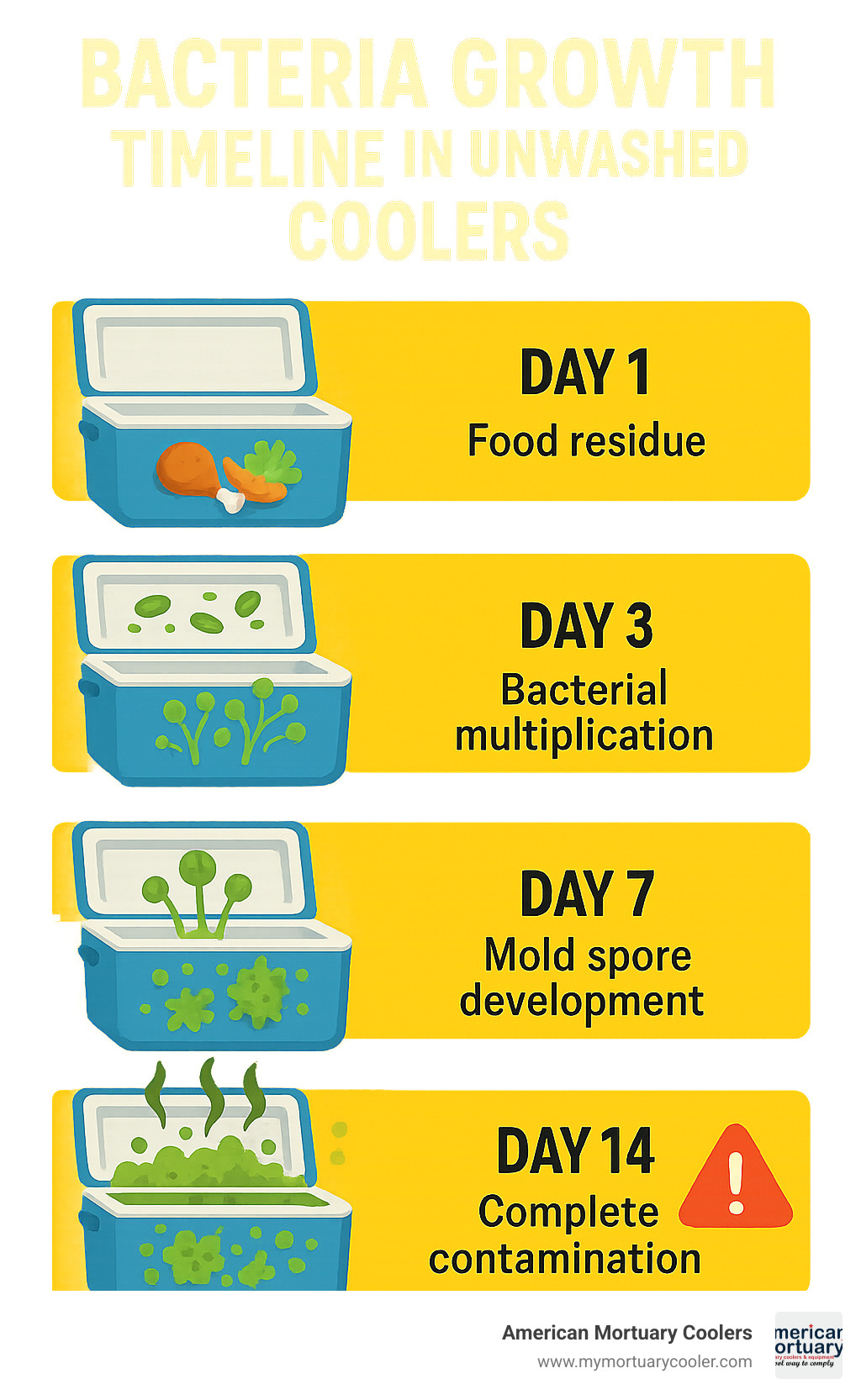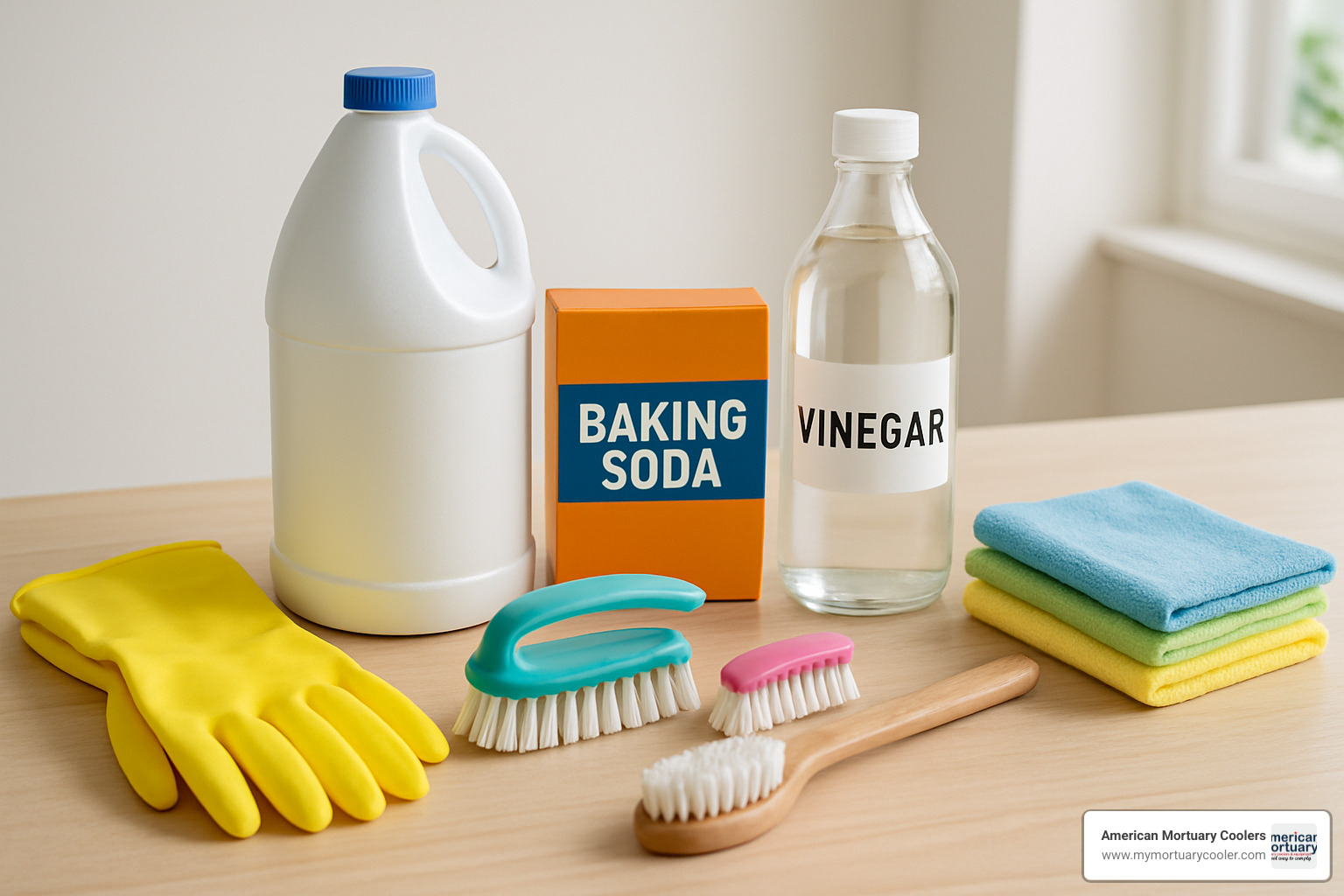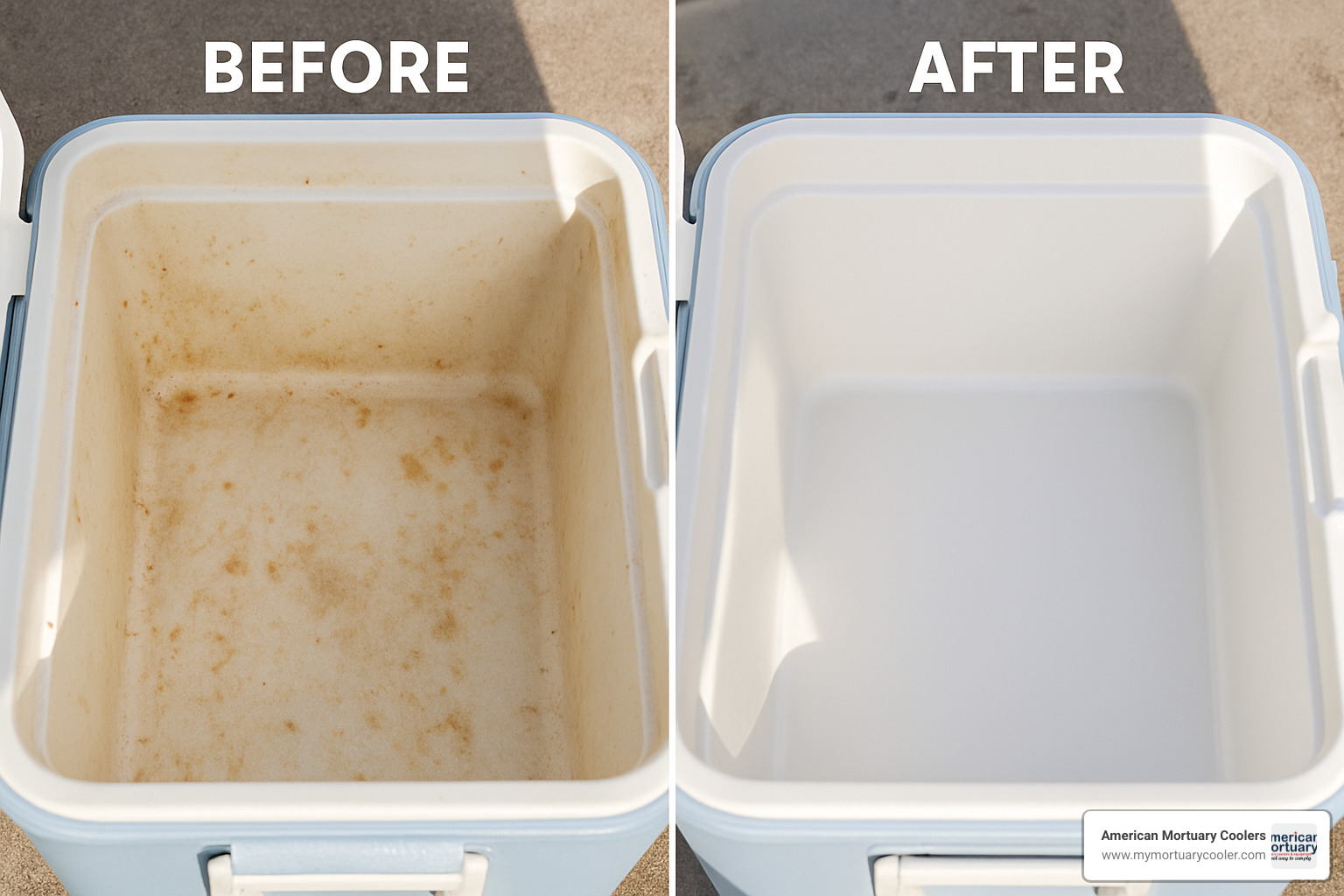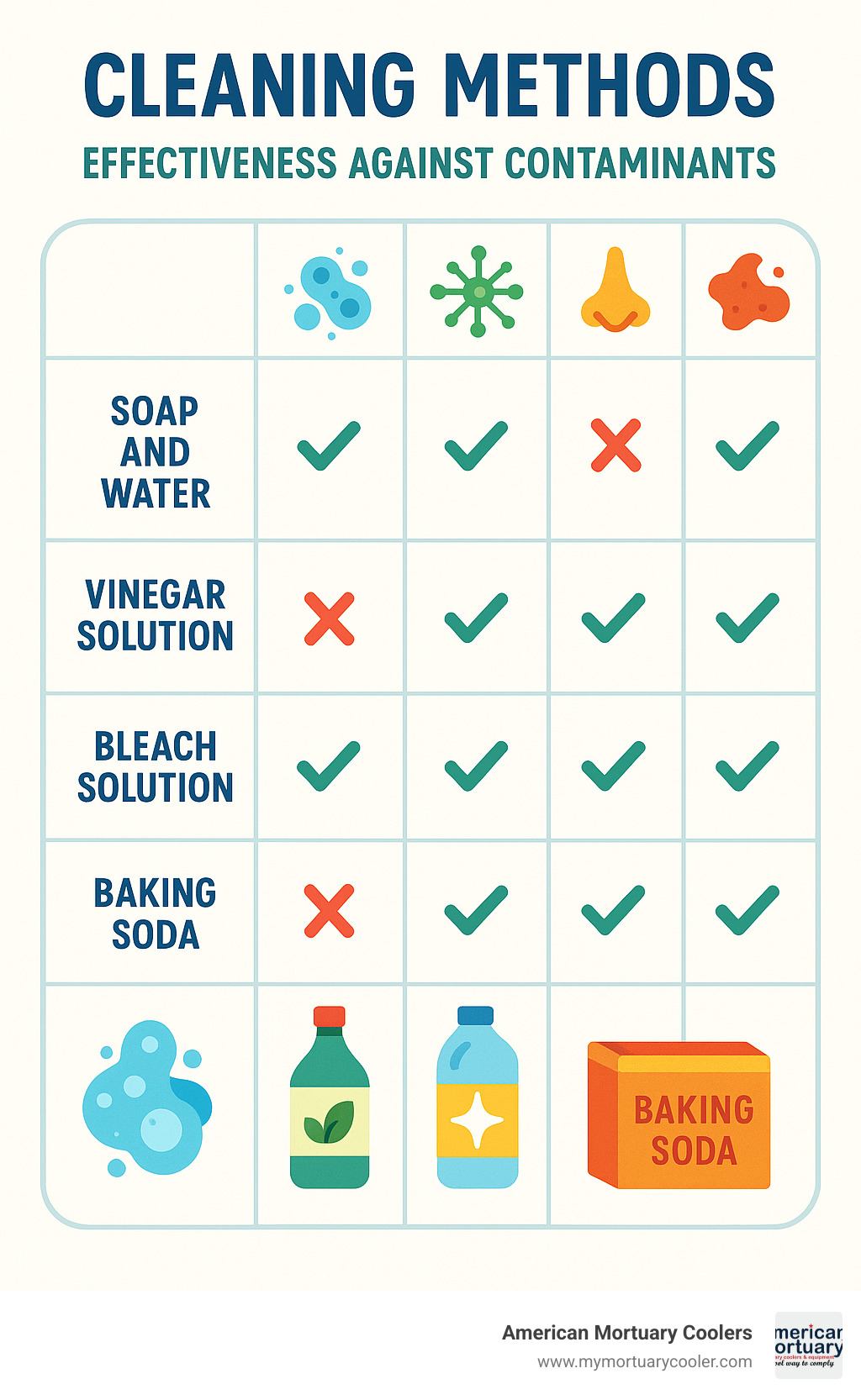Why Knowing How to Clean Cooler Properly Protects Your Investment
How to clean cooler effectively requires just four simple methods that work for any cooler type. Whether you're dealing with everyday spills or stubborn odors, these proven techniques will restore your cooler to like-new condition:
- Soap & Warm Water - For routine cleaning after each use
- Bleach Disinfectant - Mix 1/3 cup bleach per gallon of water, let sit 6 minutes, rinse thoroughly
- Natural Ingredients - Baking soda paste for stains, 1:2 vinegar spray for odors
- Deep Odor Removal - Overnight baking soda soak with undiluted vinegar for mold
A dirty cooler isn't just unsightly - it's a breeding ground for bacteria and mold that can contaminate everything inside. Research shows that cleaning your cooler after every use prevents moisture buildup that leads to expensive repairs and health hazards.
The cleaning process is straightforward: empty, rinse, apply your chosen cleaning solution, scrub gently, rinse again, and always air dry with the lid open to prevent mold growth. Most cleaning takes just 15-30 minutes but saves you from replacing equipment that costs hundreds or thousands of dollars.
As Mortuary Cooler with years of experience in commercial refrigeration systems, I've seen how proper maintenance extends equipment life and prevents costly breakdowns. My expertise in how to clean cooler systems comes from helping funeral homes maintain their critical refrigeration equipment for optimal performance and reliability.

Easy how to clean cooler word list:
Why Cleaning Your Cooler Regularly Matters
Picture this: you're excited for a weekend camping trip, but when you crack open your cooler, you're greeted by a smell that could clear a room. We've all been there, and trust me, it's not just embarrassing - it's a sign of bigger problems brewing inside your cooler.
Food safety should be your top concern when learning how to clean cooler properly. Bacteria love nothing more than the moist, food-rich environment inside a dirty cooler. These microscopic troublemakers multiply faster than rabbits in springtime, turning your cooler into a petri dish of health hazards. What starts as a few harmless crumbs becomes a bacterial bonanza that can make your next outdoor trip memorable for all the wrong reasons.
The mold and bacteria situation gets serious quickly. According to scientific research on mold and moisture, mold can establish itself in stagnant water within just a few days. Once mold moves in, it's like having the world's worst houseguest - it's incredibly difficult to evict and leaves everything smelling terrible.
Odor control becomes a losing battle once bacteria and mold take hold. That fishy smell from last month's catch or the sour milk odor from a forgotten container doesn't just disappear on its own. These odors penetrate deep into your cooler's materials, creating a permanent reminder of past neglect.
Here's something that might surprise you: equipment longevity takes a major hit when you skip regular cleaning. At American Mortuary Coolers, we've seen expensive commercial units that could have lasted decades get ruined by poor maintenance. Mold and bacteria don't just create bad smells - they literally eat away at gaskets, seals, and interior surfaces. What could have been solved with a simple cleaning routine becomes a costly replacement headache.
Energy efficiency suffers too, especially with electric coolers. When dirt and grime build up on condenser coils and air filters, your cooler has to work overtime to maintain proper temperatures. This means higher energy bills and equipment that burns out faster than it should. Our commercial clients have saved thousands of dollars annually just by following proper cleaning protocols - money that stays in their pockets instead of going to the electric company.
The bottom line? Regular cleaning breaks the cycle before small problems become big expenses. A little soap and water today prevents a lot of headaches tomorrow.
How Often & What You Need Before You Start
Here's the truth about cooler maintenance: most people wait too long. By the time you notice that funky smell, bacteria have already set up camp and started raising families.
The secret is staying ahead of the problem. After every camping trip or use, give your cooler a quick rinse - we're talking 2 minutes max. This simple habit prevents 99% of the headaches we see with neglected coolers.
Quarterly deep cleaning should be your go-to schedule for regular users. If you're like our funeral home clients who use their equipment daily, bump that up to weekly sessions. The investment in time pays off when your cooler lasts decades instead of years.
Don't skip the annual sanitizer treatment. Even if your cooler looks clean, microscopic bacteria can lurk in tiny crevices. Health departments recommend this schedule for good reason - it's your insurance policy against contamination.

Before you dive into how to clean cooler properly, gather your supplies. Think of this as your cleaning arsenal - having everything ready makes the job faster and more effective.
Safety comes first. Grab rubber gloves to protect your hands from harsh chemicals, and don't forget eye protection when working with bleach. Work outside or crack open those windows - good ventilation isn't just recommended, it's essential.
Your cleaning toolkit should include mild dish soap as your everyday hero, unscented bleach for serious disinfection (remember that magic ratio: 1/3 cup per gallon), and baking soda for stubborn odors. White vinegar cuts through mineral deposits like nobody's business and kills mold naturally.
For tools, a soft-bristled brush gets into corners where grime loves to hide, while microfiber cloths leave surfaces spotless without scratching. A garden hose with spray nozzle makes rinsing a breeze.
| Cleaning Agent | Effectiveness | Safety Level | Best For |
|---|---|---|---|
| Bleach | Excellent disinfection | Moderate (ventilation required) | Mold, bacteria, sanitizing |
| Vinegar | Good for stains/odors | High (food-safe) | Mineral deposits, natural cleaning |
| Baking Soda | Excellent deodorizer | High (completely safe) | Odors, gentle scrubbing |
The beauty of this approach? You're not just cleaning - you're preventing problems before they cost you money. At American Mortuary Coolers, we've seen too many expensive replacements that could have been avoided with the right supplies and timing.
How to Clean Cooler: 4 Step-by-Step Methods
Every cooler cleaning situation calls for a different approach. Think of these four methods as your toolkit - you might start with a gentle soap wash after a family picnic, but escalate to the heavy-duty bleach treatment after that fishing trip where someone forgot to clean out the bait cooler (we've all been there!).
The beauty of how to clean cooler properly is that you can match your method to your mess. Hard-sided coolers handle all four approaches beautifully, while soft coolers need gentler treatment. Let's walk through each method so you'll know exactly what to do in any situation.
Method 1 – Soap & Warm-Water Quick Wash
This is your everyday hero method - gentle enough to use after every camping trip but effective enough to prevent most problems before they start. It's like brushing your teeth for your cooler.
Start by emptying everything completely. I mean everything - that forgotten ketchup packet hiding in the corner, the ice that's turned into a puddle, and all removable parts like shelves or dividers. Give the whole thing an initial rinse with your garden hose to knock off the obvious debris.
Mix up some mild detergent with warm water - just a few drops of dish soap will do. You're not washing dishes here, so don't go overboard. Take a microfiber cloth and wipe down every surface, paying special attention to those corners where crumbs love to hide.
If your cooler has a drain plug, don't forget to remove it and flush out that area. Food particles love to collect there, and it's often the source of mysterious odors. After everything's wiped clean, rinse thoroughly with clean water and leave the lid open to air dry completely.
This whole process takes about 10 minutes but prevents hours of deep cleaning later. Trust me on this one.
Method 2 – How to Clean Cooler with Bleach Disinfectant
When you need serious disinfecting power, bleach is your best friend. This is the method for after storing raw meat, dealing with suspicious smells, or when someone in the family has been sick.
The magic formula is 1/3 cup bleach per gallon of water - not more, not less. This concentration kills germs without being wasteful or dangerous. The secret ingredient isn't the bleach itself, it's the 6-minute dwell time. That's how long it takes to kill bacteria, viruses, and mold spores.
Put on your gloves and make sure you've got good ventilation - open those windows or work outside. Start with a quick soap and water pre-clean to remove the obvious gunk, then mix your bleach solution in a plastic bucket.
Apply the solution with a sponge or cloth, making sure to coat every interior surface. Now comes the hardest part - waiting those full 6 minutes. Use this time to scrub any stubborn spots with a soft brush, but don't rush the process.
After your timer goes off, rinse extensively with clean water. Keep rinsing until you can't smell any bleach at all. Finally, leave the lid open to dry completely - this prevents any remaining moisture from causing new problems.
The experts at Clorox back up this approach, confirming it eliminates 99.9% of harmful microorganisms when done correctly.
Method 3 – How to Clean Cooler with Natural Ingredients
Sometimes you want cleaning power without the chemicals, especially for coolers that store food regularly. Natural cleaners work beautifully and you probably have everything you need in your kitchen right now.
Baking soda paste tackles stains like a champ. Mix 3 parts baking soda with 1 part water to create a paste that's thick enough to stick to vertical surfaces. Spread this on stained areas and let it sit for 15-20 minutes while the baking soda works its magic.
For the vinegar spray, mix 1 part white vinegar with 2 parts water in a spray bottle. This mixture cuts through grease, kills odor-causing bacteria, and costs pennies to make. Add some fresh lemon juice to boost the cleaning power and leave everything smelling fresh.
Start by emptying and rinsing your cooler, then apply the baking soda paste to any stained areas. While that's working, spray the vinegar solution on all surfaces and let it sit for 10 minutes. The acid in the vinegar breaks down grime and kills germs naturally.
Scrub gently with a soft brush, then rinse everything thoroughly with clean water. If possible, let your cooler dry in the sunlight - those UV rays provide natural sanitizing power that complements your eco-friendly cleaning approach.
Scientific research on cleaning with vinegar shows this natural approach effectively kills many harmful microorganisms while being completely safe around food.
Method 4 – Deep Odor & Mold Removal Soak
When your cooler has been sitting in the garage all winter and now smells like a swamp, this is your nuclear option. I've seen coolers that looked hopeless come back to life with this intensive treatment.
For overnight baking soda treatment, mix 1/4 cup baking soda with just enough water to make a spreadable paste. Coat the entire interior, close the lid, and walk away for 1-3 days. The baking soda absorbs odors like a sponge - it's amazing what it pulls out of seemingly clean surfaces.
Mold gets the undiluted vinegar treatment. Spray pure white vinegar directly on moldy spots and let it sit for at least an hour. The acid breaks down the mold structure, making it easy to scrub away with a brush.
After the soaking period, scrub everything with a soft brush and rinse thoroughly. If weather permits, place your cooler in direct sunlight for a few hours - the UV rays provide natural sanitizing that no chemical can match.
For a finishing touch, add a few drops of peppermint or lemon essential oil to your final rinse water. This leaves a fresh scent and provides additional antimicrobial protection.
This process takes patience - sometimes 2-3 days from start to finish - but it can save a cooler that would otherwise need replacing. At American Mortuary Coolers, we've seen this method rescue equipment worth thousands of dollars.
Tackling Tough Issues: Stains, Mold & Lingering Odors
Sometimes even the best cleaning methods meet their match. We've seen coolers that looked like crime scenes and smelled worse than a fish market in July. The good news? Almost every cooler can be saved with the right approach and a little patience.

Ink stains from soggy food labels are surprisingly common. When ice melts and soaks packaging, those colorful labels can leave permanent-looking marks. Don't panic - a simple solution of one part vinegar to two parts water lifts most ink stains right out. For the really stubborn ones, a magic eraser works wonders without scratching your cooler's surface.
Fish smell is the ultimate test of any cleaning method. Regular soap just spreads the odor around instead of eliminating it. Here's our battle-tested approach: make a thick baking soda paste and coat the entire interior overnight. The next day, scrub it out and follow with undiluted vinegar treatment. Still smell fish? Try the vanilla trick - sounds crazy, but wiping down surfaces with vanilla extract neutralizes even the strongest seafood odors.
Mildew spots need aggressive treatment before they turn into full-blown mold colonies. Spray undiluted white vinegar directly on the spots and let it sit for at least an hour. The acid literally dissolves the mold structure, making it easy to scrub away. Don't skip the waiting time - rushing this step means the mold will just come back stronger.
For organic stains that laugh at your other cleaning attempts, hydrogen peroxide is your secret weapon. The standard 3% solution from any drugstore bubbles and fizzes as it breaks down protein-based stains. Let it work for 10 minutes before scrubbing - you'll be amazed at what disappears.
Here's the reality check: severe problems rarely disappear after one cleaning session. Repeat cycles are often necessary, especially for coolers that have been neglected for months or years. We've restored coolers that took three or four cleaning rounds to get back to normal. Don't get discouraged if your first attempt doesn't solve everything - persistence pays off when learning how to clean cooler problems that seem impossible.
The key is matching your cleaning method to the specific problem. What works for ink stains might not touch fish odors, and mold requires different treatment than general stains. Take time to identify what you're dealing with before choosing your weapons.
Cleaning Different Cooler Types & Accessories
Every cooler has its own personality, and after years of working with everything from tiny camping coolers to massive walk-in units at American Mortuary Coolers, I've learned that one size definitely doesn't fit all when it comes to cleaning.
Hard-sided coolers are the workhorses of the cooler world. They can handle our aggressive bleach treatments and vigorous scrubbing without breaking a sweat. These tough units love a good deep clean and bounce back beautifully from even the most neglected conditions.
Soft-sided coolers are the sensitive types that need a gentler touch. Skip the harsh chemicals and stick with mild soap solutions. Never soak them completely - the insulation can absorb water and create a permanent mold problem. Think of them like a delicate fabric that needs careful handling.
Electric and thermoelectric coolers bring their own set of challenges. Always unplug them first (seems obvious, but you'd be surprised how often people forget). Keep water away from electrical components, and use a soft brush to clean those exterior vents. Blocked vents make these coolers work overtime and burn out faster.
When it comes to air and swamp coolers, you're dealing with honeycomb pads that need replacing every couple months during heavy use. The water tanks should get a weekly vinegar treatment to prevent those nasty mineral deposits that clog everything up.
Bottled water coolers in office settings need sanitizing every 6-12 months using our bleach method. Here's a pro tip: plug the hot-water hole during cleaning to keep contamination out of the heating system. Nobody wants funky-tasting coffee on Monday morning.
Walk-in cooler maintenance is where things get serious. These giants require condenser coil cleaning at least twice yearly, monthly door gasket maintenance, and regular interior sanitizing. From our experience at American Mortuary Coolers, proper walk-in maintenance prevents 90% of those expensive emergency service calls.
The little details matter too. Drain plugs need complete removal for thorough cleaning - check those threads and gasket condition while you're at it. Door gaskets should get monthly soap-and-water wipes, and replace them the moment you see cracks. Condenser coils respond well to gentle brushing and vacuuming to remove dust buildup.
For specialized equipment like mortuary coolers, manufacturer guidelines are your bible, but these general principles still apply. Our detailed Maintaining and Cleaning Your Mortuary Cooler for Longevity guide walks you through the specifics for professional-grade equipment.
The key to how to clean cooler systems effectively is understanding what you're working with and adjusting your approach accordingly. A little respect for each cooler's unique needs goes a long way toward keeping them running smoothly for years.
Frequently Asked Questions about How to Clean Coolers
Over the years at American Mortuary Coolers, we've fielded thousands of questions about cooler maintenance. Whether you're a weekend camper or managing commercial refrigeration, these concerns come up again and again. Let me share the answers that have helped our clients avoid costly mistakes.
Why shouldn't I close the lid while the cooler dries?
This might seem like common sense, but you'd be amazed how many people make this mistake. Closing a wet cooler is like rolling out the red carpet for mold. Even microscopic moisture droplets create the perfect breeding ground for spores that are floating around everywhere.
We've seen it happen countless times - someone finishes cleaning their cooler, thinks it looks dry enough, and closes the lid "just to keep dust out." Within 24-48 hours, you've got mold colonies setting up shop. The worst part? Once mold gets into the insulation or gasket areas, it's nearly impossible to remove completely.
Always leave that lid open until the cooler is bone dry. Put it in a sunny spot if possible, or set up a fan to speed the process. This one simple step prevents about 80% of the mold problems we see.
Is diluted bleach really food-safe after rinsing?
I get this question almost daily, and I completely understand the concern. Nobody wants to accidentally poison their family while trying to keep them safe. The good news is that properly diluted and rinsed bleach is absolutely food-safe.
The FDA actually requires bleach sanitizing in commercial kitchens and food processing plants. Our recommended ratio of 1/3 cup bleach per gallon of water is well within approved safety limits. The secret is in the rinsing - keep going until you can't smell any chlorine odor.
If you're still nervous about it, do one final rinse with clean water and let everything air dry completely. Any trace amounts will evaporate naturally. We use this exact method for our mortuary coolers, where safety standards are extremely strict.
How do I sanitize a cooler that held raw meat or fish?
Raw meat and fish are serious business when it comes to how to clean cooler systems safely. You're dealing with potential salmonella, E. coli, and other nasties that can make people seriously ill. Don't mess around with gentle cleaning methods here.
Go straight to our Method 2 bleach disinfection, but pump up the contact time to 10 minutes instead of 6. The extra time ensures you're killing everything, including the more resistant bacterial strains that sometimes survive shorter exposures.
After the bleach treatment, follow up with a thorough soap and water wash to remove any remaining organic matter. This two-step approach tackles both the safety issue and the lingering protein deposits that cause those stubborn fishy smells.
For fish odors that seem to have taken up permanent residence, finish with an overnight baking soda treatment. We've brought coolers back from what seemed like certain doom using this combination approach.

Conclusion
How to clean cooler maintenance doesn't have to be overwhelming when you break it down into manageable steps. Think of it like caring for any valuable piece of equipment - a little attention goes a long way toward protecting your investment.
The four methods we've covered give you everything needed to handle any cleaning situation. Your daily soap wash after each use prevents most problems from ever starting. When you need serious disinfection power, bleach treatment eliminates dangerous bacteria and mold. For those preferring gentler approaches, natural cleaning with vinegar and baking soda works beautifully while staying completely food-safe. And when facing a cooler that seems beyond hope, our deep treatment method can bring it back to life.
Here's the one rule that matters most: never store a cooler with the lid closed while damp. We can't stress this enough - that single mistake creates more cleaning headaches than everything else combined. Always let your cooler air dry completely with the lid propped open. Your future self will thank you.
The energy savings alone make regular cleaning worthwhile. Clean coolers run more efficiently, keeping your electric bills lower while extending equipment life. We've watched well-maintained camping coolers serve families for decades, while neglected ones become expensive paperweights within a few years.
At American Mortuary Coolers, we see this principle play out daily with our commercial clients across Tennessee, Georgia, Illinois, and beyond. Whether it's a small camping cooler or a professional walk-in unit, the fundamentals remain the same. Regular maintenance prevents expensive repairs and ensures reliable performance when you need it most.
The beauty of proper cooler care is its simplicity. Fifteen to thirty minutes of cleaning after each use prevents hours of deep-cleaning later. It's like brushing your teeth - a small daily habit that prevents major problems down the road.
For those considering commercial-grade cooling solutions, our The Complete Guide to Walk-In Cooler Features and Prices covers everything you need to know about professional equipment and maintenance requirements.
Your cooler works hard to keep things cold and safe. Return the favor with regular cleaning, and it'll serve you faithfully for years to come. After all, nothing beats the peace of mind that comes from knowing your cooling equipment is clean, efficient, and ready for whatever trip comes next.


















